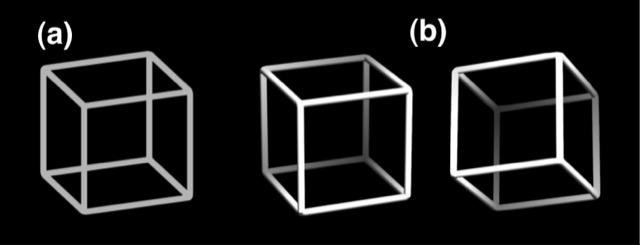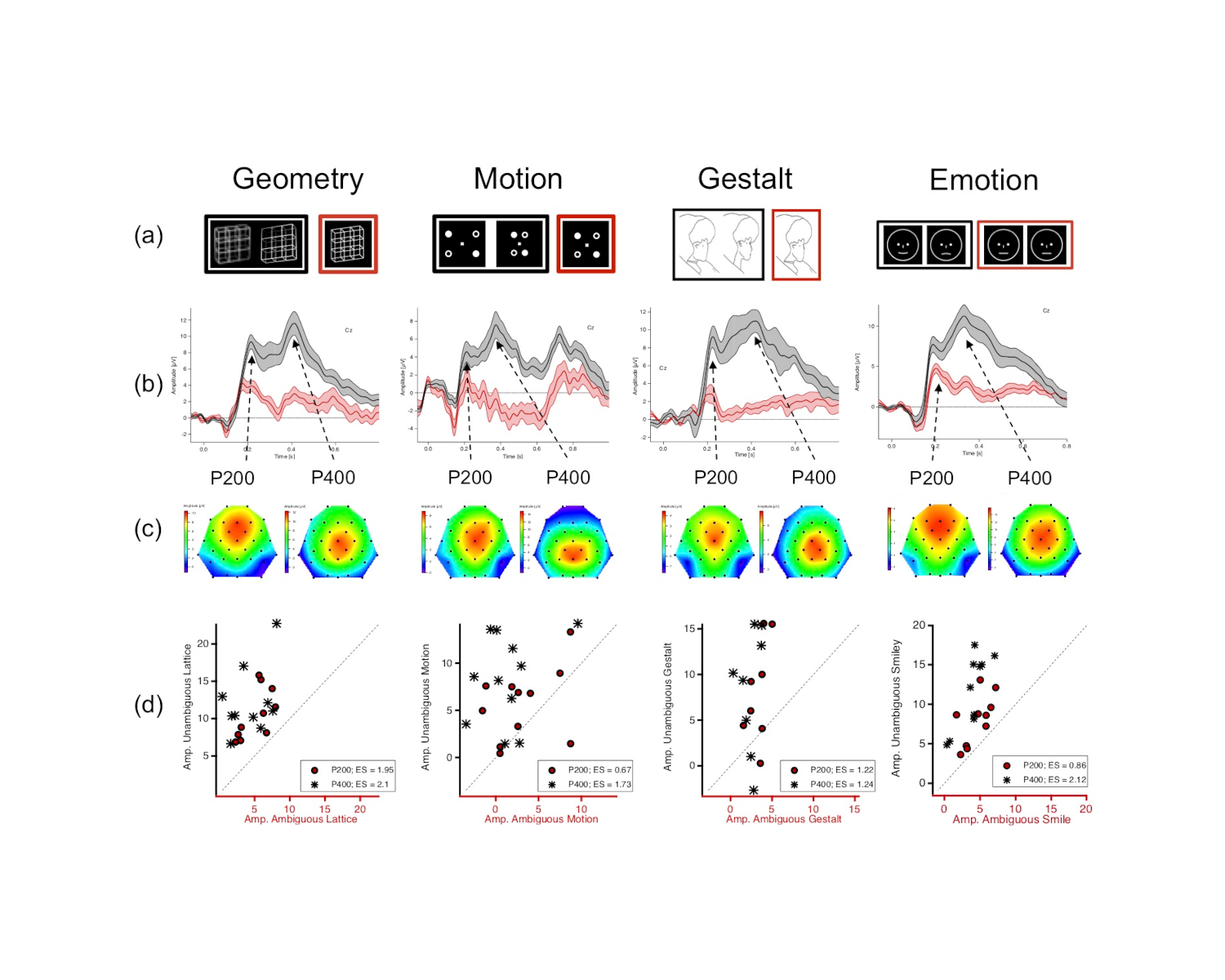Mind and Matter
During prolonged observation of the ambiguous Necker cube (Fig. 1a Necker 1832), one of the most prominent so-called ambiguous figures, our perception becomes unstable and switches spontaneously between two possible interpretations (Fig. 1b ) back and forth. When depth information is added to the image of the Necker cube, the altered cube becomes unambiguous and our perception becomes stable. In a series of EEG studies with different ambiguous stimuli and disambiguated variants, we looked for differences between the unstable neural representation of ambiguous and the stable representation of unambiguous visual information (Kornmeier & Bach 2009, Kornmeier et al. 2016, Joos et al. 2020a and 2020b). To our surprise, we found a very clear EEG pattern across fundamentally different stimulus categories with low amplitudes of two event-related potentials (“ERPs”, P200 and P400) for ambiguous stimuli and high amplitudes for unambiguous stimulus variants (Fig. 2columns 1 to 3).
However, ambiguity does not seem to be the decisive factor here, as we found very similar results when we manipulated the visibility of visual stimuli, e.g. the mouth curvature of happy and sad smileys (Fig. 2, right column), or the lines of letters (here without illustration).
In cooperation with the Department of Psychiatry and Psychotherapy at the Medical Center at the University of Freiburg and the Department of Psychiatry at the University of Strasbourg, we are investigating patients with psychiatric disorders, some of whom suffer pathologically from unstable perceptual and/or mental states, in order to test models and the resulting hypotheses and at the same time gain a better understanding of these disorders.
Fig. 2
(a) From left to right: Necker lattice (geometry), schematic representation of the so-called Motion Quartet (motion, Von Schiller 1933; online animation), Boring’s old/young woman (Gestalt, Boring 1930), smiley stimuli. The stimuli in red frames represent ambiguous, in black frames disambiguated stimulus variants. (b) Grand Mean ERP curves (middle curve) ± SEM (upper and lower curves) of EEG electrode Cz evoked by the ambiguous (red curves) and unambiguous (black curves) stimulus variants. The disambiguated stimulus variants evoke clearly recognizably higher ERP amplitudes. (c) Voltage maps for P200 and P400 show in false colors the distribution of ERP activity at a specific time point (left 200 ms and right 400 ms after stimulus onset). Red color indicates high amplitudes, blue color low amplitudes. Remarkable is the comparability of the ERP results across very different stimulus categories (columns). (d) Scatterplot showing the individual amplitude values of each subject (circles and asterisks represent P200 and P400 amplitudes). The amplitude differences are also evident at the individual level.
Publications
Boring, E. G. (1930). A new ambiguous figure. Am J Psychol, 42, 444-445. http://dx.doi.org/10.2307/1415447
Joos, E., Giersch, A., Bhatia, K., Heinrich, S. P., Tebartz van Elst, L., & Kornmeier, J. (2020). Using the perceptual past to predict the perceptual future influences the perceived present-A novel ERP paradigm. PloS One, 15(9), e0237663. https://doi.org/10.1371/journal.pone.0237663
Joos, E., Giersch, A., Hecker, L., Schipp, J., Heinrich, S. P., Tebartz van Elst, L., & Kornmeier, J. (2020). Large EEG amplitude effects are highly similar across Necker cube, smiley, and abstract stimuli. PloS One, 15(5), e0232928. https://doi.org/10.1371/journal.pone.0232928
Kornmeier, J., & Bach, M. (2009). Object perception: When our brain is impressed but we do not notice it. Journal of Vision, 9(1), 7 1-10. https://doi.org/10.1167/9.1.7
Kornmeier, J., Wörner, R., & Bach, M. (2016). Can I trust in what I see – EEG Evidence for a Cognitive Evaluation of Perceptual Constructs. Psychophysiology, 53, 1507-1523. https://doi.org/10.1111/psyp.12702
Necker, L. A. (1832). Observations on some remarkable optical phaenomena seen in Switzerland; and on an optical phaenomenon which occurs on viewing a figure of a crystal or geometrical solid. The London and Edinburgh Philosophical Magazine and Journal of Science, 1(5), 329-337. https://doi.org/10.1080/14786443208647909
Schiller, P. V. (1933). Stroboscopic alternative experiments. Psychological Research, 17, 179-214. http://dx.doi.org/10.1007/BF02411959

